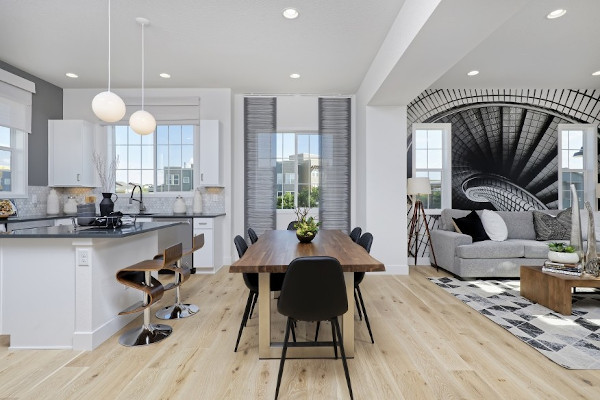The Denver-based builder has been recognized as an Indoor airPLUS Leader for the last five years.
Every year, the Environmental Protection Agency’s (EPA) Indoor Environments Division recognizes several industry organizations—from builders to raters—within its Indoor airPLUS initiative, a voluntary partnership and labeling program that helps new home builders improve the quality of indoor air.
Known as the Indoor airPLUS Leader Awards, the EPA identifies Indoor airPLUS leading organizations who promote safer, healthier, and more comfortable indoor environments and offer enhanced indoor air quality protections for their new home buyers.
For the last five consecutive years, Denver-based Thrive Home Builders has been recognized on the list, and in 2019 the builder won the top prize: Leader of the Year.
“This year, more than ever, Americans are recognizing the importance of the indoor air quality in their homes,” said David Rowson, director at the EPA’s Indoor Environments Division, in a Thrive press release. “Thrive Home Builders is at the national forefront of building homes that provide unparalleled indoor air quality, energy efficiency, and peace of mind.”
BUILDER spoke with Bill Rectanus, vice president of home building operations at Thrive Home Builders, to hear how their company is improving air quality in today’s homes, the biggest challenges, and advice to other builders on how to get started.
BUILDER: How does Thrive Home Builders promote safer, healthier, and more comfortable indoor environments?
Rectanus: It starts with our commitment. We changed our name to Thrive Home Builders in 2015 to illustrate our mission to change the way homeowners think about their homes. We stock our home's pantry with healthy foods, stock the fridge with bottled water, and find a place for the exercise bike, yet the air we breathe doesn’t always enter our minds. We set out to change that.
Then we partnered with well-respected labeling programs like the EPA’s Indoor airPLUS program (IAP), Energy Star for Homes, LEED for Homes, and the Department of Energy’s Zero Energy Ready Home program. These programs are designed to help builders implement building science, water management, and healthy home practices to provide the best health, energy efficiency, and durability benefits to our homeowners.
And we changed our building practices. Every one of our homes has a ventilation system that brings outdoor air in. We have advanced moisture management practices to keep water outside of your home, reducing mold which is an asthma trigger.
Formaldehyde and harsh chemicals are released into the air by many common building materials and household products. So, we build using paints, carpets, and wood products that keep levels of these chemicals low.
BUILDER: Thrive has been an Indoor airPLUS Leader for five years, how did the company approach indoor air quality in the beginning?
Rectanus: We have been there since the beginning. Our team built one of the first EPA Indoor airPLUS homes in the country during its pilot program back in 2006. We maintained many of those program specifications in our homes for years until we committed to 100% participation with the program in 2013. Starting with a comprehensive and detailed program like IAP gave us the guidance and education to know we had the core principles of indoor air quality correct. From this partnership and continuing education, we were able to advance our specification levels even beyond the IAP program and know that we were making the best decisions for our homeowners.
BUILDER: What is the biggest challenge to developing better indoor air quality in homes?
Rectanus: The biggest challenge to developing better indoor air quality is remembering that the house is a system. By this I don’t just mean a ventilation system, I’m referring to the way all the parts and pieces of the home work together. Superior indoor air quality is dependent on addressing the entire system to include sound building science, water management, ventilation, and product selection practices.
BUILDER: How have new or potential homeowners reacted to increased indoor air quality pre-COVID? And post-COVID?
Rectanus: Indoor air quality is always a strong selling point. We might need to convince a potential homeowner the benefits of energy efficiency, for example, but our buyers know they care about health. We only need to outline how our homes support health.
The focus on health has only increased due to COVID. In Colorado, we had the added air quality threat caused by severe forest fires. It’s driven demand for new homes and, particularly, homes with the most advanced HVAC and ventilation systems.
BUILDER: What advice can you give to other builders looking to incorporate more healthy measures?
Rectanus: We would advise other builders to partner with a reputable program like the Indoor airPLUS program. We also recommend partnering with a strong building science adviser to insure you are properly looking at the entire home as a system and don’t inadvertently build in any issues that could negatively impact your otherwise good intentions.
BUILDER: How will Thrive continue to evolve its indoor air quality practices? What’s next?
Rectanus: Thrive has begun to look more deeply into health beyond just indoor air quality. We started to offer new items like HEPA filtration, air quality monitors, humidification, touchless faucets, water filtration, and bidet and self-cleaning toilets. We will continue to monitor the acceptance of these types of healthy home features and see how we push the agenda forward with offerings that are meaningful to our homeowners.
(Image: Interiors of Thrive Home Builders' Arista three-story rowhome located between Denver and Boulder, Colorado. The rowhomes are both EPA Indoor airPLUS certified and LEED certified, are solar-powered, and start at $470,900.)

